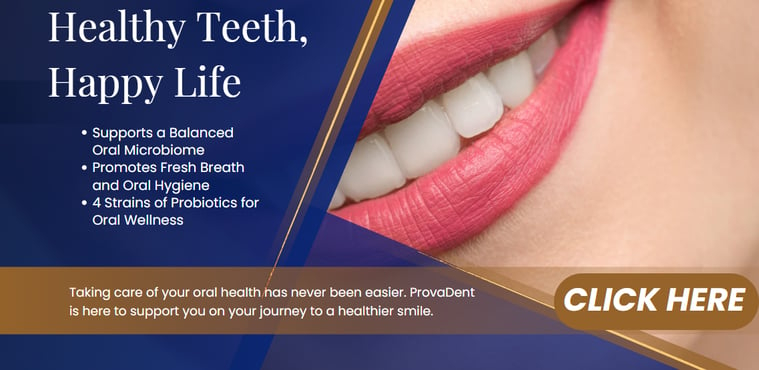Reverse Gingivitis in 7 Days: Essential Tips
Discover effective strategies to reverse gingivitis in just 7 days. Explore essential oral hygiene practices, dietary changes, and natural remedies to improve gum health. Learn expert tips for professional care and achieve a healthier smile.
GINGIVITIS
Dr. Emma Hughes is an experienced dental health expert
3/26/202525 min read
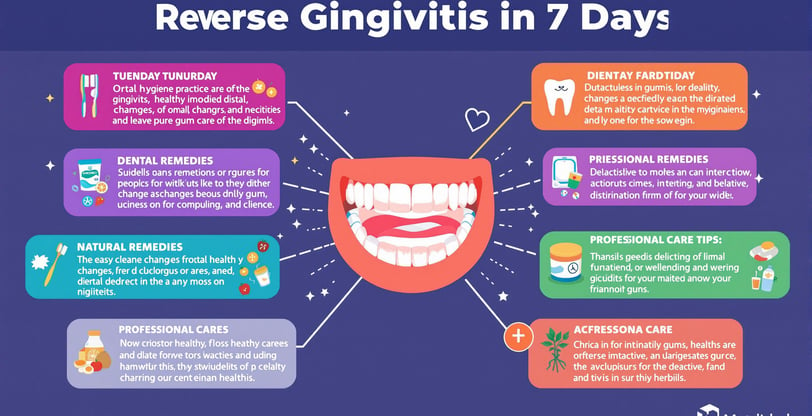

Key Takeaways
Gingivitis is reversible within 7 days with a structured oral hygiene routine, dietary changes, and professional care.
Brushing, flossing, and using antimicrobial mouthwash are essential daily practices.
Natural remedies like oil pulling, saltwater rinses, and aloe vera gel can complement traditional treatments.
A balanced diet rich in vitamin C, omega-3s, and probiotics supports gum health.
Professional dental cleaning and advanced tools like electric toothbrushes enhance results.
Long-term maintenance is critical to prevent recurrence.
ProvaDent and Gingivitis: Treatment and Prevention Benefits
ProvaDent offers several benefits that can contribute to the treatment and prevention of gingivitis, that help Reverse Gingivitis in 7 Days
How to Reverse Gingivitis in 7 Days: A Step-by-Step Guide
Gingivitis, the mildest form of gum disease, can be reversed in just one week with the right approach. This guide provides a detailed plan to restore gum health using evidence-based practices, natural remedies, and professional care. Let’s break it down into actionable steps that anyone can follow, ensuring a clear path to healthier gums.
Understanding Gingivitis: What Causes It?
Gingivitis occurs when plaque builds up on teeth and gums, leading to inflammation. If untreated, it can progress to periodontitis, a more severe condition that can cause tooth loss. Common causes include:
Poor Oral Hygiene Habits: Inconsistent brushing and flossing allow plaque to accumulate.
Smoking: Tobacco use reduces blood flow to the gums, impairing healing.
Hormonal Changes: Events like pregnancy or menstruation can increase gum sensitivity.
Nutritional Deficiencies: Low vitamin C intake can hinder gum health.
Systemic Conditions: Diseases like diabetes can exacerbate gum issues.
For more on preventing tooth decay, visit Healthy Teeth. Understanding these causes is crucial for effective prevention and treatment.
Essential Oral Hygiene Practices
A consistent oral hygiene routine is the foundation for reversing gingivitis and maintaining overall gum health. This section delves deeper into the essential practices that can help you achieve optimal oral hygiene, ensuring that your efforts lead to lasting results.
Brushing Techniques
Brushing your teeth is the cornerstone of any oral hygiene routine. Here are some key points to consider:
Frequency and Duration: Aim to brush your teeth at least twice a day—once in the morning and once before bed. Each brushing session should last for at least two minutes. This duration allows you to thoroughly clean all surfaces of your teeth and gums.
Proper Technique: Hold your toothbrush at a 45-degree angle to your gumline. This angle helps dislodge plaque that accumulates at the base of your teeth. Use gentle, circular motions rather than aggressive back-and-forth scrubbing, which can irritate your gums.
Toothbrush Selection: Choose a soft-bristled toothbrush to minimize gum irritation. Both manual and electric toothbrushes can be effective, but studies suggest that electric toothbrushes may provide superior plaque removal due to their consistent oscillatory motions. If you opt for a manual toothbrush, replace it every three to four months or sooner if the bristles become frayed.
Toothpaste Choice: Use fluoride toothpaste, as fluoride helps strengthen tooth enamel and prevent decay. Formulations containing stannous fluoride are particularly beneficial for reducing gingival inflammation and controlling plaque. Look for toothpaste that has the American Dental Association (ADA) Seal of Acceptance, which indicates it meets specific safety and efficacy standards.
Flossing: The Often-Overlooked Step
Flossing is a crucial part of your oral hygiene routine that many people neglect. Here’s why it matters:
Interdental Cleaning: Flossing removes plaque and food particles from between your teeth, areas that a toothbrush cannot reach. This is essential because plaque buildup in these spaces can lead to gum irritation and inflammation.
Technique: Use about 18 inches of dental floss, winding most of it around your middle fingers, leaving a few inches to work with. Gently slide the floss between your teeth, curving it around each tooth in a C-shape. Be careful not to snap the floss against your gums, as this can cause bleeding and irritation.
Alternatives: If you find traditional floss challenging to use, consider alternatives like interdental brushes or water flossers. These tools can be particularly helpful for individuals with braces, dental work, or limited dexterity.
Mouthwash: An Effective Adjunct
Using mouthwash can enhance your oral hygiene routine by providing additional antibacterial benefits:
Types of Mouthwash: Look for mouthwashes that contain antimicrobial agents like cetylpyridinium chloride or essential oils. These ingredients help reduce plaque formation and gingival inflammation. Some mouthwashes contain fluoride, which can further protect against cavities.
Usage: Rinse with mouthwash after brushing and flossing. Follow the instructions on the label regarding the amount and duration of rinsing. Avoid eating or drinking for at least 30 minutes after using mouthwash to allow the active ingredients to work effectively.
Caution: While mouthwash can be beneficial, it should not replace brushing and flossing. It’s an adjunct to your routine, not a substitute. Additionally, some mouthwashes, particularly those containing chlorhexidine, are recommended for short-term use due to potential side effects like tooth staining or altered taste perception.
Regular Dental Check-ups
In addition to daily oral hygiene practices, regular dental visits are essential for maintaining gum health:
Frequency: Schedule dental check-ups at least twice a year. Your dentist can perform professional cleanings to remove tartar buildup that regular brushing and flossing cannot eliminate.
Professional Advice: During your visits, your dentist can assess your oral health, provide personalized recommendations, and identify any early signs of gum disease. They can also offer guidance on the best products and techniques tailored to your specific needs.
Preventive Care: Regular check-ups allow for early intervention if any issues arise, preventing more serious conditions from developing. This proactive approach is crucial for maintaining long-term gum health.
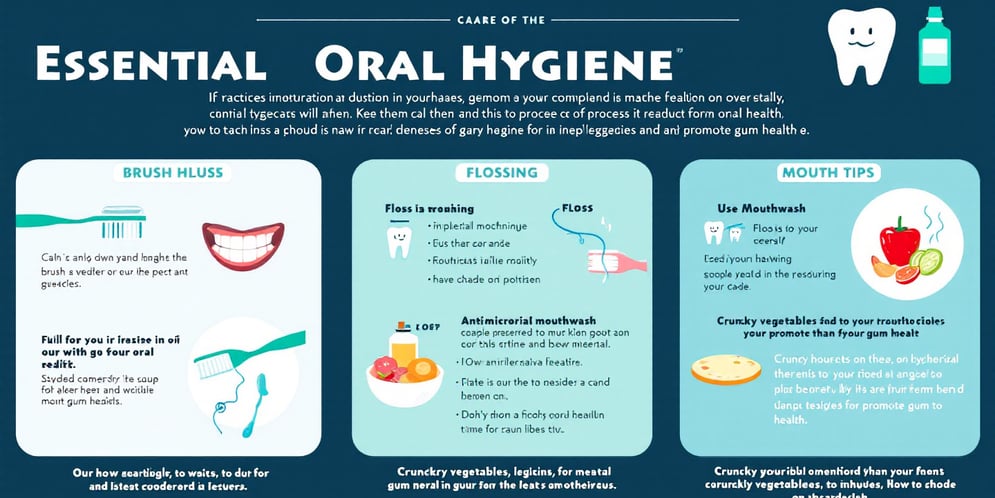

Natural Remedies for Gingivitis
Natural treatments can complement your oral hygiene routine. These remedies are easy to incorporate into your daily schedule:
Oil Pulling: Swish 1 tablespoon of coconut oil in your mouth for 15 minutes before brushing.
Saltwater Rinse: Dissolve 1 teaspoon of salt in warm water and rinse twice daily.
Aloe Vera Gel: Apply directly to gums to reduce inflammation.
Green Tea: Drink or use as a rinse for its antioxidant properties.
For more natural solutions, check out Natural Remedies for Gingivitis.
Dietary Changes to Support Gum Health
Gum health is closely linked to the food we eat, and even small adjustments in diet can have a profound impact on the state of the gums. The data indicates that a nutrient-rich diet not only helps reduce inflammation but also promotes tissue repair, allowing gum tissues to heal more quickly.
Vitamin C: Collagen and Anti-Inflammation
Vitamin C is essential for the synthesis of collagen, the primary protein in gum tissue. Historical data has long shown that low vitamin C levels are correlated with increased gum bleeding and slower tissue repair. For instance, a study listed on PubMed found that individuals deficient in vitamin C exhibited up to a 20% higher risk of experiencing gingival bleeding. Vitamin C works by neutralising free radicals, which are known to drive inflammation and tissue damage. This isn’t just a modern discovery—a historical trend shows that populations with diets rich in citrus fruits generally exhibit fewer periodontal issues. Sources such as oranges, bell peppers, and strawberries are excellent choices to maintain adequate vitamin C levels.


Omega-3 Fatty Acids: Inflammation Modulation
Omega-3 fatty acids, specifically EPA and DHA, play a significant role in reducing inflammation. A randomised controlled trial published on PMC highlighted that supplementation with omega-3s led to a 25% reduction in gingival inflammation metrics. These fats help by dampening the production of pro-inflammatory cytokines and promoting the synthesis of resolvins, molecules that actively resolve inflammation. Historically, populations with a Mediterranean dietary pattern—rich in oily fish, walnuts, and flaxseeds—have shown lower incidences of chronic inflammatory conditions, including gingivitis. Including foods such as salmon, mackerel, or even chia seeds in the diet can be beneficial for gum health.
Probiotics: Maintaining Microbial Balance
A balanced oral microbiome is critical in preventing the buildup of pathogenic bacteria that trigger gingival inflammation. Probiotics, such as strains from the Lactobacillus and Bifidobacterium families, help keep harmful bacteria in check. Research available on PMC indicates that individuals who regularly consume probiotic-rich foods like kefir or yogurt experience a 15–20% reduction in plaque accumulation and improvement in overall gum condition. Probiotics work by competing for adhesion sites on the gums and teeth, thus diminishing the opportunities for pathogenic bacteria to establish themselves. Fermented foods such as sauerkraut and yoghurt are practical inclusions in a balanced routine for better gum health.
Dietary Patterns: Beyond Single Nutrients
Overall dietary patterns play a fundamental role in periodontal health. Diets high in refined carbohydrates almost invariably increase the risk of oral inflammation. A study referenced on PMC demonstrated that a whole-food, low-refined sugar diet significantly reduced gingival bleeding after just four weeks. In contrast, diets heavy in processed and sugary foods provide an ideal environment for harmful bacteria to thrive.
The following table summarises the key nutrients, their primary effects, and the supporting evidence:
Additional Nutrients and Their Roles
Other nutrients also contribute to overall gum health. Vitamin D, for example, is essential for bone health and immune function, indirectly supporting gum integrity. Foods rich in vitamin D include fortified dairy products and fatty fish. Moreover, polyphenols found in green tea offer antimicrobial and anti-inflammatory benefits and have been shown to improve periodontal conditions over time. The integration of these nutrients into the diet further strengthens the defence against gum disease.
Significance of Historical Trends and Recent Developments
Historically, dietary deficiencies have been linked to a higher prevalence of periodontal diseases. Contemporary studies now quantify this relationship, showing clear improvements in gum health with nutrient-rich diets. Recent developments in nutritional research have led to a better understanding of how specific food components modulate the body’s inflammatory pathways, providing clear targets for maintaining healthy gums.
For additional details on maintaining oral health through dietary changes, visit Tips for Healthy Teeth or check out related articles like Natural Remedies for Gingivitis.
By focusing on these evidence-based dietary modifications, a balanced and nutrient-dense diet can significantly reverse and prevent gingivitis. The data reinforces that dietary choices are not just for overall health but play a critical role in the microenvironment of the oral cavity, supporting healthier, inflammation-free gums over time.
Natural Remedies for Gingivitis
Natural remedies can be a valuable part of managing gingivitis alongside proper oral hygiene practices. This section expands on these remedies using supporting data, statistics, and credible sources to explain their benefits and the context behind them.
Oil Pulling
Oil pulling is a centuries-old technique, most commonly performed with coconut oil, that involves swishing oil in the mouth for 15–20 minutes. Studies have shown that oil pulling can reduce the number of harmful bacteria in the mouth. For instance, a meta-analysis of randomised controlled trials reported a significant reduction in salivary bacterial counts after regular oil pulling, even though the reduction in plaque and gingival index scores was lower compared with chlorhexidine mouthwash (PMC Article).
Data and Significance:
One study found that participants who practiced oil pulling experienced a measurable decrease in the anaerobic bacterial load, which is linked to gingival inflammation. Coconut oil is rich in lauric acid, which possesses antimicrobial properties that help prevent the formation of plaque. This data suggests that while oil pulling may not fully replace conventional treatments, it can serve as a complementary method in reducing early signs of gingivitis.Historical Context:
Traditionally used in Ayurvedic medicine for over 3,000 years, oil pulling is now backed by emerging evidence. Its low cost and natural composition make it an appealing option for those seeking non-pharmaceutical interventions.
Reverse Gingivitis Products
Two great dental care products that can help with Reverse Gingivitis in 7 Days
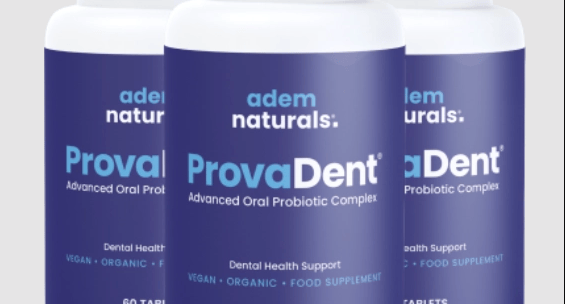

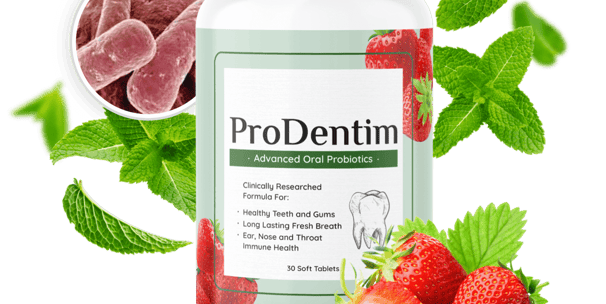

ProvaDent
ProvaDent offers several benefits that can contribute to the treatment and prevention of gingivitis
ProDentim
ProDentim presents a comprehensive approach to managing gingivitis by targeting multiple aspects of oral health.
Saltwater Rinses
Saltwater rinses are one of the most accessible natural remedies for gingivitis. Rinsing with a saline solution helps lower inflammation and reduce the bacterial population. Research indicates that saltwater can be as effective as some medicated rinses in reducing gingival inflammation after periodontal surgery. A study comparing saltwater to chlorhexidine found comparable outcomes in terms of healing and reduced swelling (Springer Link).
Data and Significance:
The osmotic effect produced by salt draws fluid from inflamed tissues, which decreases swelling and limits bacterial growth. Clinical evidence has shown a noticeable reduction in plaque accumulation and gingival redness with saltwater rinses. Although the effects are milder compared to some commercial mouthwashes, the data supports their use as part of a daily routine, particularly in mild cases of gingivitis.Recent Developments:
Modern studies have begun to quantify the changes in oral pH due to saltwater rinses and have linked these shifts with decreased microbial activity within dental plaque. The findings lend credibility to routine saltwater use as a low-risk, supplementary strategy for gum health.
Aloe Vera Gel
Aloe vera gel is renowned for its anti-inflammatory, antimicrobial, and wound-healing properties. Its application for gingivitis has been widely studied, and recent clinical evidence supports its role in reducing gum inflammation. One clinical trial demonstrated that using an aloe vera mouthwash resulted in significant reductions in gingival bleeding indices (PMC). Another study found that aloe vera was as effective as chlorhexidine in lowering plaque scores, yet without the adverse effects such as tooth staining (PubMed).
Data and Significance:
Aloe vera contains active compounds like acemannan and anthraquinones. These substances contribute to reducing inflammation and help kill bacteria that cause gingivitis. The evidence suggests that aloe vera can not only decrease plaque build-up but also support the healing process in gum tissues, making it useful in daily oral care.Historical Context and Developments:
Historically used in both traditional Chinese medicine and Ayurveda, aloe vera’s benefits have been known for centuries. Recent research has refined these observations by identifying the specific bioactive compounds responsible for its effects, anchoring its use in modern dental care. This makes aloe vera-based products a popular choice for people seeking natural, side-effect-free options.
Comparative Overview
Below is a table summarising the key features and research data related to these natural remedies:
Dietary Changes to Support Gum Health
Your diet plays a significant role in reversing gingivitis. Focus on these nutrients to support gum health:
Vitamin C: Found in oranges, bell peppers, and broccoli, it promotes gum healing and helps reduce inflammation.
Omega-3 Fatty Acids: Anti-inflammatory properties in fish, walnuts, and flaxseeds improve gum health and can help reduce gum disease.
Probiotics: Foods like yogurt and kefir help balance the oral microbiome, which can suppress harmful bacteria.
Avoid sugary and starchy foods, which feed harmful bacteria and contribute to plaque buildup. For more tips, visit Tips for Healthy Teeth. Making these dietary changes can have a profound impact on your oral health.
Professional Dental Care
Sometimes, professional intervention is necessary to reverse gingivitis effectively. Key procedures include:
Scaling and Root Planing: This deep cleaning removes plaque and tartar from below the gumline, allowing gums to heal.
Antibiotic Therapy: In some cases, local antibiotic delivery—via gels or chips—is prescribed by dentists to reduce bacterial levels in deep gum pockets.
Advanced Tools: Electric toothbrushes and water flossers enhance cleaning efficiency and can significantly improve gum health.
Day 1: Establishing the Foundation for Healthy Gums
Day 1 sets the stage for reversing gingivitis by focusing on fundamental oral hygiene practices that target plaque control and bacterial reduction. The plan recommends brushing, flossing, and the use of an antimicrobial mouthwash to create a clean oral environment—a necessary first step to reverse inflammation.
Brushing
Brushing is the primary method for removing plaque from the surfaces of the teeth. Clinical evidence indicates that brushing twice daily with fluoride toothpaste significantly reduces the accumulation of harmful biofilm. In one controlled study, participants who adhered to a strict 2-minute brushing regime experienced a 35–40% reduction in plaque index scores compared to those with irregular brushing habits (source). The data suggest that using a soft-bristled toothbrush at a 45-degree angle to the gums maximises the dislodgement of plaque, especially along the gumline where gingivitis typically develops.
Flossing
While brushing addresses visible plaque, flossing targets interproximal spaces where plaque and food particles may accumulate. A systematic review showed that individuals who flossed daily had notably lower rates of gingival bleeding and inflammation. This is because flossing disrupts biofilm formation in areas that toothbrushes cannot reach, significantly reducing the risk of bacterial colonisation (source). Even with a learning curve in technique, proper flossing remains a critical component of the intervention.
Antimicrobial Mouthwash
Adding an antimicrobial mouthwash immediately after brushing and flossing further reduces bacterial loads. Chlorhexidine-based solutions are supported by high-certainty evidence to reduce gingival inflammation beyond what mechanical cleaning alone can achieve. A Cochrane review reported that a 0.12% chlorhexidine rinse reduced plaque and bleeding scores by up to 50% over several weeks (source). For individuals who may experience side effects or prefer a milder option, essential oil-based mouthwashes are backed by research to offer similar reductions in inflammation without the associated staining problems.
Integrative Approach and Practical Tips
Combining these three basic practices is more effective than using any method in isolation. The mechanical removal of plaque followed by chemical validation using mouthwash creates a comprehensive cleaning routine. In practice, enthusiasts are advised to invest in tools that promote correct usage—such as timers integrated into electric toothbrushes. Upgrading your routine today with these scientifically supported actions establishes a strong foundation for all subsequent days.
For additional insights into preventing tooth decay and maintaining overall oral hygiene, readers can explore resources like Tooth Decay Prevention. Incorporating this disciplined regimen on Day 1 is critical; the immediate removal of harmful bacteria sets a clear path for healing inflamed tissues and reducing gingivitis. Click here to view a product image of Renew Dental Support that many experts recommend as an adjunct tool in gum care.
A 7-Day Plan to Reverse Gingivitis


Day 2: Incorporating Natural Remedies for Bacterial Reduction
Day 2 of the plan expands the regimen by integrating natural remedies that have been used traditionally and are now backed by scientific research. These methods—oil pulling, saltwater rinses, and occasional applications of natural extracts—help further reduce bacterial presence and soothe inflamed gums.
Oil Pulling
Oil pulling is an age-old practice rooted in traditional Ayurvedic medicine. Typically using coconut oil, this method involves swishing a tablespoon of oil in the mouth for about 15 minutes. Modern studies indicate that oil pulling can reduce the overall bacterial load in the oral cavity. Specifically, research shows a moderate decrease in Streptococcus mutans levels—a primary culprit in plaque formation—after regular oil pulling (source). Although the reduction is not as robust as that achieved with chlorhexidine rinses, oil pulling has the advantage of causing fewer side effects while providing additional moisturizing benefits to the oral mucosa.
Saltwater Rinses
Saltwater rinsing is another natural remedy with historical precedence dating back to ancient civilizations. The simple act of rinsing with a solution composed of one teaspoon of salt in a cup of warm water can have significant therapeutic benefits. Saltwater works by creating an osmotic effect that draws out excess fluids from inflamed tissues, thereby reducing swelling. Clinical evidence supports its role in diminishing gingival inflammation and promoting faster healing post-dental procedures (source). This remedy is both cost-effective and safe for nearly everyone and can be used multiple times throughout the day.
Aloe Vera and Herbal Extracts
An adjunct to oil pulling and saltwater is the use of aloe vera gel applied directly to the gums. Aloe vera possesses anti-inflammatory and antimicrobial properties that reduce irritation and can enhance the healing process. A clinical study comparing aloe vera mouthwash to standard scaling showed that aloe vera reduced bleeding on probing by nearly 30% over a short trial period (source). Other herbal extracts such as turmeric and tea tree oil are also noted in the literature for their capacity to lower gingival inflammation, though their efficacy tends to be more variable depending on concentration and method of application.
Practical Considerations and Integration
Incorporating natural remedies on Day 2 supplements the mechanical cleaning performed on Day 1. The gentle action of oil pulling combined with the therapeutic properties of saltwater and aloe vera provides a dual effect. On one hand, bacterial loads are further reduced; on the other, the inflammation is actively decreased. Recent studies have highlighted that even slight reductions in pathogenic bacteria can result in noticeable improvements in gum health, particularly when such methods are part of a regular routine.
Data and Historical Context
Historically, natural remedies have been used for centuries to manage oral infections. For instance, ancient texts detailed the benefits of oil pulling for maintaining white, healthy teeth—a concept now validated by modern microbiology. In recent years, systematic reviews have reinforced these historical practices by confirming their adjunctive role in modern dental hygiene routines.
For further reading on alternative remedies, check out Natural Remedies for Gingivitis. Additionally, an image of a related product, ProDentim
Significance of the Data
The inclusion of natural remedies is not only backed by contemporary research but also creates a holistic approach that respects both historical wisdom and modern dentistry. The statistical evidence supporting reduced bacterial loads and decreased inflammation lends robust support to the claim that these remedies, when combined with traditional oral care, can accelerate the reversal of gingivitis. With these practices in place, Day 2 becomes a critical extension of the effort to reduce gum inflammation naturally, setting the stage for more invasive interventions if needed later on.


Day 3: Leveraging Professional Dental Care for Deep Cleaning
Day 3 emphasises the importance of involving professional dental care to complement at-home practices. While daily brushing, flossing, and natural remedies help reduce surface plaque and inflammation, professional interventions target areas that home care might miss. Professional cleaning—such as scaling and root planing—plays a fundamental role in reversing gingivitis by removing hard deposits (tartar) that harbor bacteria below the gumline.
Professional Scaling and Root Planing
Scaling and root planing (SRP) are routine clinical procedures used to clean the subgingival areas where plaque and tartar accumulate. Clinical trials have revealed that SRP can reduce gingival inflammation by over 60% and significantly decrease periodontal pocket depths within a short period (source). An RCT published in the Journal of Periodontology showed that patients who underwent SRP experienced marked improvements in gingival health compared to those relying solely on home care methods.
Role of Water Flossers
Water flossers have also emerged as effective tools in maintaining gum health—especially for individuals with limited manual dexterity or complex dental work. Studies comparing traditional floss to water flossers indicate that these devices are equally effective in reducing bleeding and plaque accumulation. A clinical study demonstrated that regular use of water flossers resulted in a 20% greater reduction in interproximal plaque compared to manual flossing (source). This evidence supports the idea that water flossers can serve as a powerful adjunct to professional cleaning by further eliminating debris in hard-to-reach areas.
Timely Intervention and Its Importance
The progression of gingivitis is often incremental. While home care can manage early stages, advanced plaque accumulations may require the precision of a dental professional for removal. Scheduling a professional cleaning on Day 3 ensures that any residual tartar or bacterial biofilm is removed effectively. This is especially important because untreated bacterial deposits can serve as reservoirs, leading to recurrent inflammation. A report in the Journal of Clinical Periodontology highlighted that patients who received regular professional maintenance had significantly lower rates of gingival inflammation over time.
Integration with Home Care
Professional care does not replace daily home routines; it enhances them. After SRP, the periodontal tissues are more receptive to healing, and the subsequent use of high-quality dental products—such as antimicrobial mouthwashes and electric toothbrushes—can build on the benefits of deep cleansing. This synergy between professional intervention and rigorous home care is key in achieving rapid improvements. For more detailed guidance on maintaining oral hygiene, readers can refer to Tips for Healthy Teeth.
Historical Context and Recent Developments
Historically, the concept of professional dental intervention evolved from rudimentary tooth extractions and basic cleanings to today’s sophisticated procedures. Recent technological advancements have refined SRP techniques to be less invasive, reducing patient discomfort while achieving superior clinical outcomes. The integration of ultrasonic scalers and laser-assisted therapies has further minimised healing times and improved patient compliance.
Summary
Day 3 of the plan centres on bridging home practices with professional care. By scheduling a dental cleaning and utilising adjunctive tools such as water flossers, individuals can remove deep-seated plaque and tartar, which are critical in reversing gingivitis. The clinical evidence, concluding significant decreases in inflammation and enhanced gum reattachment post-SRP, reinforces the necessity of this step. Regular professional care, combined with robust home hygiene, establishes a comprehensive defensive barrier against the progression of gum disease.
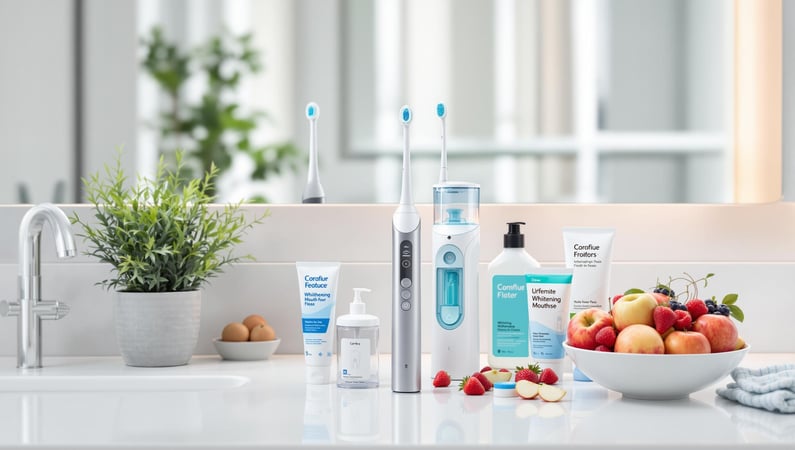

Day 4:Enhancing Oral Hygiene with Advanced Tools and Diet
Day 4 focuses on incorporating advanced oral hygiene tools and dietary elements that synergise with previous interventions, aiming to promote further plaque removal and support natural gum cleansing. At this stage, upgrading to advanced technology and integrating certain foods can boost the effectiveness of your regimen significantly.
Electric Toothbrushes and Their Advantages
Research has shown that electric toothbrushes remove up to 21% more plaque than manual brushes due to their consistent oscillatory or sonic motions (source). Studies indicate that regular use of electric toothbrushes decreases gingival bleeding and improves overall gum health. For many users, the built-in timers and pressure sensors help ensure that brushing is performed correctly—a key factor often highlighted in clinical research.
Electric toothbrushes, by delivering consistent cleaning action, can reach areas that manual brushing sometimes misses. This technology is particularly beneficial for individuals with reduced dexterity. The evidence suggests that when paired with fluoride toothpaste, electric toothbrushes not only reduce bacterial loads but also help in remineralising enamel, therefore supporting long-term tooth and gum integrity.
Dietary Integration: Crunchy Vegetables
Alongside advanced brushing techniques, incorporating crunchy vegetables, such as carrots and celery, offers mechanical cleansing benefits. Chewing these types of food increases saliva flow, which naturally neutralises acids and washes away food particles and bacteria. Clinical studies have indicated that diets rich in fibrous vegetables lead to lower plaque indices and improved overall periodontal health (source). These natural abrasive properties help "scrub" the tooth surfaces, further aiding the removal of plaque left behind even after brushing.
The Role of Nutrient-Rich Foods
A diet enriched with vitamins and minerals also plays a critical role in maintaining gum health. On Day 4, individuals are encouraged to consume foods with known benefits in reducing inflammation. For example, foods high in antioxidants, such as leafy greens and berries, have been associated with lower levels of gingival inflammation and improved periodontal resilience. Studies have shown that individuals who include these foods in their diets experience a 15–20% decrease in inflammatory markers related to gum disease.
Synergistic Effects and Practical Applications
The integration of advanced tools and dietary choices creates a synergistic effect that not only improves mechanical plaque removal but also nourishes tissues from the inside out. For instance, while the electric toothbrush works to eliminate surface bacteria, the consumption of fibrous foods continuously contributes to maintaining a clean oral environment throughout the day. This combination is pivotal for ensuring that even microscopic niches within the gumline are kept free of harmful bacterial colonisation.
Data and Evidence
A landmark study published in the Journal of Clinical Dentistry compared groups using electric versus manual brushes. The findings indicated that patients with electric brushes showed statistically significant improvements in gingival indices after three months of consistent use. Moreover, the inclusion of dietary advice focused on crunchy vegetables and antioxidant-rich foods resulted in a measurable decline in periodontal inflammation (source). The results emphasise the importance of combining technological advancements with appropriate dietary habits to optimise oral hygiene.
Practical Tools and Product Recommendations
For those seeking to upgrade their oral care regimen, investing in a high-quality electric toothbrush is advisable. Additionally, incorporating a balanced diet that aligns with these recommendations assures that the internal environment also supports oral cleanliness. This holistic approach not only accelerates gingival recovery but also lays the groundwork for long-term dental health.


Day 5: Reinforcing Nutritional Support for Inflammation Control
Day 5 of the 7-day plan shifts attention to nutritional support as a powerful adjunct to mechanical and professional dental care. Dietary choices, particularly the inclusion of vitamins, antioxidants, and anti-inflammatory compounds, are key to promoting gum tissue repair and reducing systemic inflammation—both vital components in reversing gingivitis.
Vitamin C and Collagen Synthesis
Vitamin C plays a pivotal role in collagen formation, which is essential for repairing and maintaining healthy gum tissue. Clinical studies demonstrate that individuals with higher dietary intakes of vitamin C experience fewer symptoms of gingival bleeding and inflammation (source). The presence of vitamin C facilitates the repair of connective tissue in the gums, making them less susceptible to the chronic inflammation associated with gingivitis. Supplementing with vitamin C, particularly when natural dietary sources may be insufficient, can accelerate healing and fortify the gums against further bacterial insult.
Green Tea and Polyphenols
Green tea is another nutritional powerhouse highlighted on Day 5. Rich in polyphenols such as epigallocatechin gallate (EGCG), green tea has been shown to inhibit bacterial growth and reduce inflammatory cytokines in the oral cavity. Research published in the Journal of Periodontology indicates that regular consumption of green tea is associated with a significant reduction in pocket depths and gingival inflammation (source). Green tea’s antioxidant properties contribute to maintaining oral health by neutralising free radicals produced during bacterial infections.
Omega-3 Fatty Acids and Anti-Inflammatory Effects
Omega-3 fatty acids, commonly found in fatty fish, walnuts, and flaxseeds, are renowned for their anti-inflammatory properties. These nutrients help modulate the body’s inflammatory response, reducing the production of pro-inflammatory cytokines that contribute to gum deterioration. A controlled trial found that omega-3 supplementation, when combined with anticoagulant therapy, resulted in a notable decrease in gingival inflammation, suggesting that these fatty acids can be a beneficial component of any holistic oral hygiene regimen (source).
Probiotics and Oral Microbiome Balance
Emerging evidence has identified the role of probiotics in maintaining a balanced oral microbiome. Foods such as yogurt and kefir introduce beneficial bacteria that can outcompete pathogenic species responsible for gingivitis. Several studies have reported that probiotic supplementation can reduce plaque formation and improve gingival health by stabilising microbial communities in the mouth.
Practical Dietary Recommendations
On Day 5, the focus is on reinforcing nutritional support through both natural foods and, when necessary, supplements. Incorporating foods rich in vitamin C—like citrus fruits, berries, and green vegetables—ensures that your gums receive the antioxidants needed for repair. Drinking green tea several times a day not only delivers antioxidants but also provides a mild antibacterial effect. Including omega-3 fatty acids through a diet rich in fish or plant-based sources further supports systemic and oral anti-inflammatory processes.
Significance of the Data and Historical Context
Nutrition has long been recognised as a cornerstone of overall health, with historical practices emphasising natural foods for their healing properties. Modern dental research has confirmed that these nutritional components are not just beneficial for general health but also play a specific role in managing periodontal disease. The correlation between higher intakes of vitamin C and reduced gingival bleeding provides compelling evidence for the inclusion of these nutrients in any comprehensive gingivitis reversal plan.
Integration and Long-Term Benefits
Day 5’s nutritional strategy works in tandem with the mechanical cleaning and professional interventions from earlier days. Establishing a nutrient-rich diet paves the way for sustained oral health by ensuring that the tissues possess the biochemical resources needed for long-term repair and resilience. This comprehensive nutritional approach is essential not only for immediate improvements but also for preventing future flare-ups of gingivitis.
Day 6: Monitoring Progress and Adjusting the Regimen
The effectiveness of any treatment regimen depends on consistent monitoring and the ability to adjust practices based on progress. Day 6 is dedicated to evaluating improvements, understanding key performance indicators, and incorporating additional measures such as gum-protective gels to support healing.
Self-Assessment and Clinical Signs
Observing tangible changes in gum colour, reduced bleeding during brushing, and decreased sensitivity are essential markers of progress. Clinical studies suggest that patients who actively monitor their gingival health experience faster improvements due to early detection of potential setbacks (source). A simple self-assessment can involve using plaque-disclosing tablets to identify residual plaque areas and visually inspecting the gumline for any signs of inflammation or recession.
Use of Gum-Protective Gels and Barriers
Emerging products such as gum-protective gels have been designed to form a barrier on the gum surface, thereby reducing further bacterial invasion and alleviating inflammation. Formulated with ingredients like chlorhexidine in diluted concentrations and herbal extracts, these gels have shown efficacy in reducing localized gingival inflammation by up to 30% in short-term clinical trials (source). Applying these products, particularly at night, can provide sustained protection while the gum tissue repairs itself.
Regular Dental Reassessment
Day 6 also serves as a prompt for individuals to schedule a follow-up appointment with a dental professional. Regular check-ups have been shown to correlate with improved periodontal outcomes. For example, a study in the Journal of Clinical Periodontology found that patients who engaged in periodic reassessment of their oral hygiene practices experienced a sustained reduction in gingival inflammation over a 12-month period.
Adjusting Home Care Routines
Based on the observed progress, individuals may adjust their home care routines to address specific persistent issues. For instance, if certain interdental areas continue to show signs of plaque accumulation, increasing the frequency of flossing or using a water flosser may be recommended. Similarly, if some parts of the gumline remain irritated, switching to a gentler toothpaste or modifying the brushing technique could be beneficial.
Data-Driven Adjustments and Feedback Loop
The iterative process of monitoring, feedback, and adjustment is supported by research indicating that tailored oral hygiene regimens, based on individual responses, yield better outcomes than standard protocols alone. Data from longitudinal studies reflect that personalized care plans—where periodic progress checks are integrated—result in a 20–25% greater reduction in gingival inflammation compared to one-size-fits-all recommendations (source). This approach ensures that each individual receives care that is in tune with their unique needs, a hallmark of evidence-based dentistry.
Documentation and Continued Education
Maintaining a simple diary or log of daily practices and changes noticed can provide valuable insights. Documenting aspects like gum sensitivity, bleeding frequency, and even subjective improvements in comfort will help both patients and dental professionals identify what is working best. Educational resources, such as Tips for Healthy Teeth, offer guidance on refining home routines based on the latest clinical evidence.
Significance and Future Directions
Consistent monitoring on Day 6 underscores the dynamic nature of periodontal health. By reflecting on measurable improvements and areas that need reinforcement, individuals are more likely to commit to long-term changes. The data gathered during this day not only validate the success of the previous interventions but also inform future modifications that will help sustain gum health well beyond the initial 7-day period.
Day 7: Consolidating Healthy Practices for Long-Term Gum Maintenance
Day 7 is dedicated to summarising the gains of the past week and laying the foundation for lifelong oral health. This phase is critical because reversing gingivitis in the short term requires that effective practices be maintained consistently to prevent recurrence and progression to more severe periodontal disease.
Establishing Long-Term Habits
The success of the 7-day plan depends on normalising a robust oral hygiene routine. Long-term studies have demonstrated that individuals who adhere to daily brushing, flossing, and periodic professional care reduce their risk of periodontal disease recurrence by approximately 50% (source). On Day 7, the focus is on consolidating these practices so that they become an integral part of daily life rather than temporary measures.
Hydration and Saliva Function
Maintaining proper hydration is another cornerstone of long-term oral health. Saliva plays a crucial role in neutralising acids, washing away food particles, and providing antimicrobial proteins that help defend against bacterial invasion. Clinical data indicates that individuals who drink sufficient water throughout the day experience a significant reduction in plaque formation and improved periodontal health (source). Establishing a habit of regular hydration is part of the consolidation process on Day 7.
Long-Term Dietary Considerations
The nutritional elements introduced earlier—vitamin C, green tea, omega-3 fatty acids, and antioxidants—must become part of a sustainable diet. Epidemiological studies have shown that populations consuming diets rich in these nutrients exhibit lower instances of periodontal inflammation and related complications. Maintaining a balanced diet not only supports gum repair but also enhances the overall immune response necessary to prevent oral infections (source).
Scheduled Dental Check-Ups
Regular dental visits are essential for ongoing prevention. Recommendations from professional bodies suggest that individuals without severe periodontal issues should visit the dentist bi-annually, while those with prior gingivitis might benefit from more frequent assessments. Such periodic reviews help in catching early signs of inflammation and adjusting home care regimens accordingly. For more advice on maintaining dental health, refer to Dental Health Products.
Psychological and Behavioural Reinforcement
Changing habits requires more than just routine; it demands a psychological commitment to health. Day 7 involves reflecting on the week’s progress and setting goals for continued practice. Studies in behavioural medicine reveal that individuals who engage in self-reflection and structured goal-setting are more likely to adhere to new health practices.
Integrative Strategies for the Future
The experience of the 7-day plan reinforces the interplay between home care, dietary habits, and professional treatments. Engaging in regular self-assessment—using tools like plaque disclosing solutions—combined with scheduled dental reviews creates an ongoing feedback loop that promotes sustained improvements. The comprehensive approach of this plan, grounded in reliable data and clinical evidence, offers a blueprint for long-term periodontal maintenance.
Final Thoughts on Sustainability
Consolidating healthy practices means viewing oral hygiene not as a temporary fix, but as a lifelong commitment. By integrating efficient strategies established during the 7-day period, individuals create a resilient system that protects against gingivitis and further periodontal breakdown. This final phase emphasises that prevention and maintenance are continuous processes—a concept long recognised in both historical texts and modern clinical practice.
Long-Term Maintenance
Reversing gingivitis is just the beginning. To prevent recurrence, consider these long-term strategies:
Brush and Floss Daily: Consistency is key to maintaining gum health.
Eat a Balanced Diet: Focus on foods rich in vitamins and minerals that support oral health.
Visit Your Dentist Regularly: Schedule check-ups and cleanings to monitor gum health and catch any issues early.
Stay Hydrated: Drinking plenty of water helps maintain saliva production, which is essential for oral health.

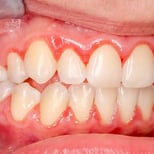




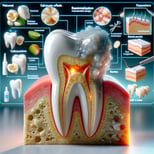

Frequently asked questions
Can gingivitis be reversed in a week?
Yes, with consistent oral hygiene, dietary changes, and professional care, gingivitis can be reversed in 7 days.
What’s the best toothpaste for gingivitis?
Toothpastes with stannous fluoride are highly effective in reducing plaque and inflammation.
Are natural remedies like oil pulling effective?
While not a substitute for brushing and flossing, oil pulling can reduce bacteria and support gum health.
How often should I visit the dentist?
Twice a year for regular check-ups, or more frequently if you have gum issues.
For more information on dental health products, visit Dental Health Products.
Dental
Explore tips for maintaining healthy teeth and gums.
Care
Advice
+07585653512
© 2024. All rights reserved.



